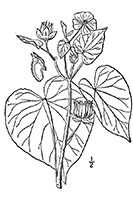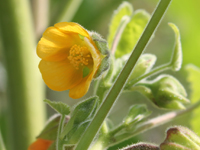![]()
Velvetleaf is an annual plant in the mallow family, native to southern Asia. Velvetleaf grows as a weed primarily in cropland, especially corn fields, and it can also be found on roadsides and in gardens. In Midwestern and northeastern regions of the United States, eastern Canada and the Eastern Mediterranean, velvetleaf is considered a damaging weed to agricultural crops, especially corn and soybeans. Since being introduced to North America in the 18th century, velvetleaf has become an invasive species in agricultural regions of the eastern and Midwestern United States. It is one of the most detrimental weeds to corn causing decreases of up to 34% of crop yield if not controlled and costing hundreds of millions of dollars per year in control and damage. Velvetleaf is an extremely competitive plant, so much so that it can steal nutrients and water from crops. Velvetleaf is controllable by herbicides. Velvetleaf has been grown in China since around 2000 BCE for its strong, jute-like fibre. The common name "velvetleaf" comes from the heart-shaped, and fined haired, leaves of the plant. Its specific name "theophrasti" commemorates the ancient Greek botanist-philosopher Theophrastus.
![]()
A fibre obtained from the stems of velvetleaf is used as a jute substitute. Velvetleaf is also used in rope-making. The fibre is also used for making paper, the stems are harvested in the summer, the leaves removed and the stems are steamed in order to remove the fibres.
![]() Within the realm of rational and holistic medicine, velvet leaf can be used in the treatment of dysentery and opacity of the cornea. The leaves contain 0.01% rutin and are used as a demulcent; or can be made into a poultice and applied to ulcers. A tea made from the dried leaves is used in the treatment of dysentery, urinary incontinence, and fevers. The bark is an astringent and a diuretic. The seeds can be powdered and eaten in the treatment of dysentery, stomach-aches, or used as a laxative.
Within the realm of rational and holistic medicine, velvet leaf can be used in the treatment of dysentery and opacity of the cornea. The leaves contain 0.01% rutin and are used as a demulcent; or can be made into a poultice and applied to ulcers. A tea made from the dried leaves is used in the treatment of dysentery, urinary incontinence, and fevers. The bark is an astringent and a diuretic. The seeds can be powdered and eaten in the treatment of dysentery, stomach-aches, or used as a laxative.
Please note that MIROFOSS does not suggest in any way that plants should be used in place of proper medical and psychological care. This information is provided here as a reference only.
![]()
The seeds of the velvetleaf plant can be eaten raw when they are under-ripe. The ripe seed is dried and ground into a powder then used in soups and breads. The seeds contain approximately 17.4% protein, 16% fat, 33.8% carbohydrate, and 4.4% ash.
MIROFOSS can not take any responsibility for any adverse effects from the consumption of plant species which are found in the wild. Always seek advice from a professional before using a plant for human, or animal, consumption.
![]()
Velvetleaf can grow in light (sandy), medium (loamy) and heavy (clay) soils and prefers well-drained soil. Suitable pH: acid, neutral and basic (alkaline) soils and can grow in very alkaline soils. It can grow in semi-shade (light woodland) or no shade. It prefers dry or moist soil. Velvetleaf prefers rich and cultivated soils, such as those used in agriculture.
| Soil Conditions | |
| Soil Moisture | |
| Sunlight |
![]()
Velvetleaf is an annual plant which can grow 100cm to 200cm tall and has velvet-like cordate shaped leaves which can be 15cm to 25cm wide. The flowers of velvetleaf can be yellow or orange and are 4cm in diameter. Flowers are single or in small clusters from the leaf axils, each with five large sepals and five yellow to yellow-orange petals, 13mm to 25mm wide when open; the filaments untied to form a central column as in the mallows; the fruit form each flower is a circular cluster of 12 to 15 seedpods about 13mm 25mm long, at first green but turning dark brown to black at maturity, each individual pod opening with a vertical slit down its back and containing several purplish-brown, V-shaped seeds about 1mm long.
![]()
| Plant Height | 100cm to 200cm |  |
| Habitat | Fields, Waste Places | |
| Leaves | Cordate | |
| Leaf Margin | Entire | |
| Leaf Venation | Cross-Venulate | |
| Stems | Finely Hairy | |
| Flowering Season | July to October | |
| Flower Type | Radially Symmetrical | |
| Flower Colour | Yellow | |
| Pollination | Bees, Insects | |
| Flower Gender | The flowers are hermaphrodite (have both male and female organs) | |
| Fruit | Hard kidney shaped seeds | |
| USDA Zone | 8A (-12°C to -9°C) cold weather limit |
![]()
No known health risks have been associated with velvetleaf However ingestion of naturally occurring plants without proper identification is not recommended.
![]()
 |
-Click here- or on the thumbnail image to see an artist rendering, from The United States Department of Agriculture, of velvetleaf. (This image will open in a new browser tab) |
![]()
 |
-Click here- or on the thumbnail image to see a magnified view, from The United States Department of Agriculture, of the seeds created by velvetleaf for propagation. (This image will open in a new browser tab) |
![]()
Velvetleaf can be referenced in certain current and historical texts under the following nine names:
Velvetleaf can be translated into the following select languages:
| Arabic | Bulgarian | каркаде | Chinese (Sim) | 苘麻 | |
| Croatian | mračnjak | Czech | Danish | fløjlsblad | |
| Dutch | Esperanto | Estonian | |||
| Finnish | samettilehti | French | German | Velvetail | |
| Greek | βελούδο | Hebrew | קטיפה | Hungarian | selyemmályva |
| Italian | Japanese | ベルベットリーフ | Korean | 벨벳 잎 | |
| Punjabi | Lithuanian | Norwegian | |||
| Persian | تابلو فرش | Polish | Portuguese | ||
| Romanian | catifelate | Russian | Теофраста | Slovak | abutilon |
| Spanish | terciopelo | Swedish | Tagalog | balabal | |
| Turkish | kadife | Ukrainian | Сечовий міхур Кемпіон | Vietnamese | vải nhung |

![]()
 |
The MIROFOSS database offers free printable garden tags for personal and non-profit use. These tags can be used to properly identify plant samples in a garden. Click on the tags shown on the the screen or -click here- to download a full size jpeg image for a velvetleaf identification tag; which can be printed on paper or used with a plastic laser printer. |
 |
What's this? What can I do with it? |
![]()
| Description | Kartesz, J.T. 1999. A synonymized checklist and atlas with biological attributes for the vascular flora of the United States, Canada, and Greenland. First edition. In: Kartesz, J.T., and C.A. Meacham. Synthesis of the North American Flora, Version 1.0. North Carolina Botanical Garden, Chapel Hill, N.C. |
| Description | Meades, S.J. & Hay, S.G; Brouillet, L. 2000. Annotated Checklist of Vascular Plants of Newfoundland and Labrador. Memorial University Botanical Gardens, St John's NF. 237pp. |
| Description | The Nature Conservancy. 2001. Map: TNC Ecoregions of the United States. Modification of Bailey Ecoregions. Online . Accessed May 2003. |
| Folklore | Kleonikos G. Stavridakis , Κλεόνικος Γ. Σταυριδάκης (2006). Wild edible plants of Crete - Η Άγρια βρώσιμη χλωρίδα της Κρήτης. Rethymnon Crete. ISBN 960-631-179-1. |
| Biology | Dickinson, T.; Metsger, D.; Bull, J.; & Dickinson, R. (2004) ROM Field Guide to Wildflowers of Ontario. Toronto:Royal Ontario Museum, |
| Image Rendering | USDA-NRCS PLANTS Database / USDA NRCS. Wetland flora: Field office illustrated guide to plant species. USDA Natural Resources Conservation Service. |
| Environment | National Audubon Society. Field Guide To Wildflowers (Eastern Region): Alfred A. Knopf. ISBN 0-375-40232-2 |
| Physical Identification | National Audubon Society. Field Guide To Wildflowers (Eastern Region): Alfred A. Knopf. ISBN 0-375-40232-2 |
| February 15, 2018 | The last time this page was updated |
| ©2021 MIROFOSS™ Foundation | |
 |
|







